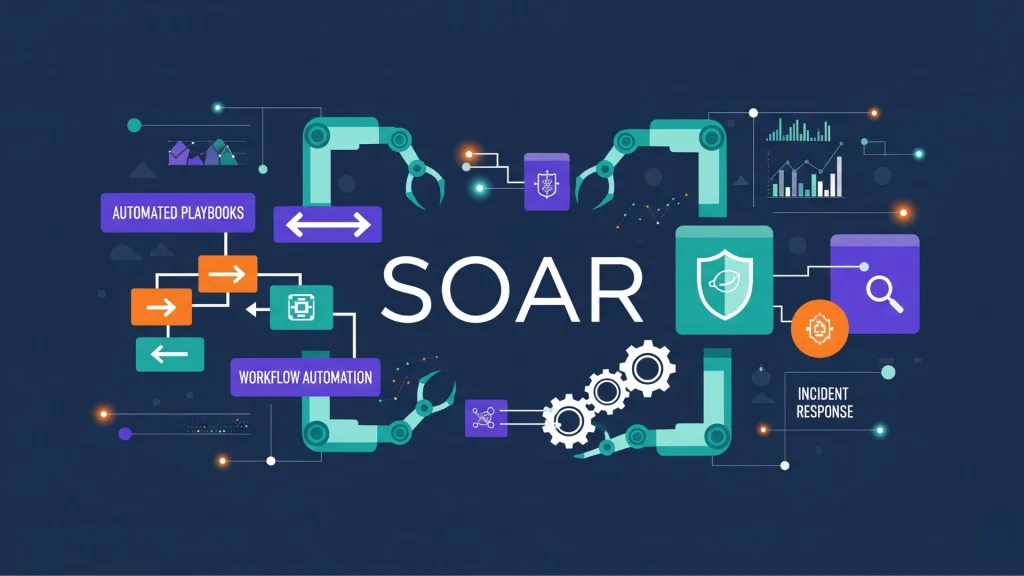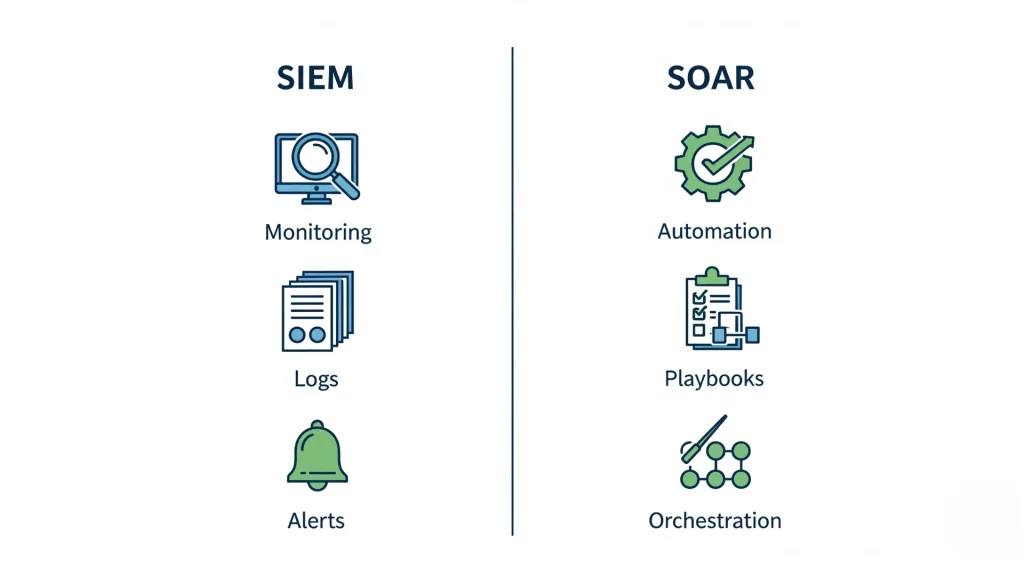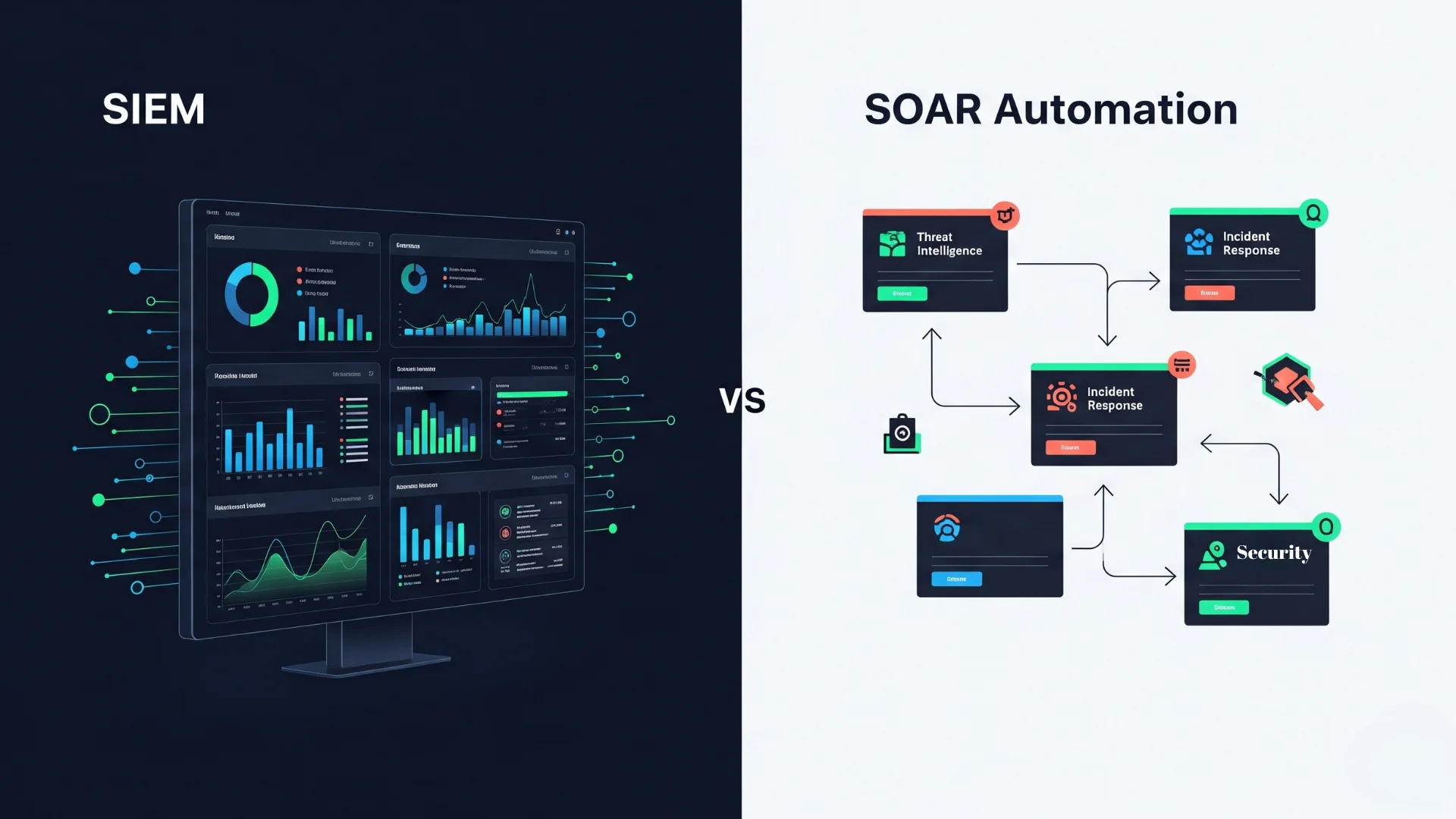The world of cybersecurity is filled with tools that detect, analyze, and respond to threats. Two of the most important technologies every beginner hears about are SOAR vs SIEM. While both are crucial for security operations, they serve different purposes.
In this guide, we’ll explore SOAR vs SIEM, define each one, explain their key differences, show practical use cases, and help you decide which one to learn first. By the end, you’ll clearly understand where SIEM fits in security monitoring and how SOAR enhances incident response automation.
What Is SIEM?

When comparing SOAR vs SIEM, it makes sense to start with SIEM since it’s the foundation of modern security operations.
SIEM (Security Information and Event Management) is a system that collects and analyzes data from across an organization’s IT infrastructure. It is used by Security Operations Centers (SOCs) to detect suspicious behavior and generate alerts.
Core Functions of SIEM:
- Log Collection and Management: Gathers logs from firewalls, endpoints, and servers.
- Correlation and Analysis: Detects unusual activity patterns.
- Alerting: Warns analysts about suspicious events.
- Compliance Reporting: Provides necessary reports for audits.
SIEM doesn’t directly respond to incidents—it focuses on monitoring and detection. That’s why in SOAR vs SIEM comparisons, SIEM is often seen as the first layer of defense.
Popular SIEM Tools: Splunk, Microsoft Sentinel, IBM QRadar, ArcSight, LogRhythm.
What Is SOAR?

The other half of the SOAR vs SIEM equation is SOAR.
SOAR (Security Orchestration, Automation, and Response) is a platform that automates and coordinates security operations. Instead of just alerting, SOAR executes playbooks and workflows to respond to threats.
Core Functions of SOAR:
- Automation: Handles repetitive tasks automatically, like blocking IPs.
- Orchestration: Integrates multiple security tools into one workflow.
- Incident Playbooks: Standardized responses for phishing, malware, or insider threats.
- Case Management: Tracks incidents, assigns analysts, and keeps documentation.
While SIEM gives you visibility, SOAR gives you speed and efficiency. In SOAR vs SIEM comparisons, this is the main distinction—SOAR acts while SIEM detects.
Popular SOAR Tools: Palo Alto Cortex XSOAR, Splunk SOAR, IBM Resilient, Swimlane.
Key Differences Between SIEM and SOAR

To really understand SOAR vs SIEM, let’s break down their differences:
| Feature | SIEM | SOAR |
| Role | Detection and monitoring | Orchestration and automated response |
| Data Handling | Collects logs and generates alerts | Uses SIEM data to trigger actions |
| Alerts | Notifies analysts | Automates remediation |
| Human Involvement | Analysts review alerts manually | Reduces manual work with automation |
| Compliance | Strong compliance reporting | Limited compliance use |
| Integration | Central monitoring hub | Connects SIEM + tools for response |
In summary: In SOAR vs SIEM, SIEM is about “knowing what’s happening,” while SOAR is about “acting on it quickly.” Both are essential for a mature SOC.
Use Cases for SIEM vs SOAR
When evaluating SOAR vs SIEM, use cases highlight why both are important.
SIEM Use Cases:
- Detecting brute-force login attempts.
- Spotting insider threats via unusual access patterns.
- Monitoring compliance for regulations like GDPR or HIPAA.
- Aggregating logs from cloud and on-prem systems.
SOAR Use Cases:
- Automatically isolating compromised machines.
- Blocking malicious IPs in real-time.
- Handling phishing emails with automated analysis.
- Reducing analyst workload by filtering false positives.
A SOAR vs SIEM strategy often combines both: SIEM detects a suspicious login attempt, and SOAR locks the account automatically.
Which One Should You Learn First and Why?
If you’re a beginner wondering about SOAR vs SIEM career paths, here’s the answer:
- Start with SIEM: It’s the foundation of SOC work. Almost all Tier-1 SOC jobs require SIEM skills.
- Advance to SOAR: Once you’re comfortable with SIEM, learn SOAR to automate responses and design playbooks.
Learning SIEM first gives you a solid base. Then, when you add SOAR, you stand out in the job market. Employers value professionals who understand the full SOAR vs SIEM workflow.
Certification Paths and Tools
Building expertise in security operations requires both theoretical knowledge and practical hands-on skills. Certifications provide structured learning, while tools allow you to apply what you’ve learned in real-world environments.
SIEM Certifications
- Splunk Core Certified Power User / Admin – Validates your ability to search, use fields, create alerts, and manage dashboards in Splunk. It’s one of the most recognized entry-level certifications for SIEM.
- Microsoft Security Operations Analyst (SC-200) – Focuses on detecting, investigating, and responding to threats using Microsoft Sentinel and Microsoft 365 Defender. Ideal for those aiming to work in cloud-driven environments.
- IBM QRadar SIEM Foundation – Provides foundational knowledge for one of the most widely used SIEM platforms in enterprise settings.
- Elastic Certified Engineer – Designed for professionals who want to master the ELK Stack (Elasticsearch, Logstash, Kibana), which is often used in open-source SIEM deployments.
SOAR Certifications
- Palo Alto Cortex XSOAR Certified Engineer – Focuses on building, testing, and deploying playbooks for automated incident response.
- Splunk SOAR Certified Automation Developer – Covers automation design, custom app creation, and complex playbook building for Splunk SOAR environments.
- IBM Resilient SOAR Certification – Provides knowledge in configuring and running IBM’s SOAR solution, with an emphasis on incident orchestration and playbook execution.
Hands-On Tools and Labs
While certifications strengthen your resume, tools and labs give you the confidence to perform in real-world SOC environments. Some recommended practice options include:
- Wazuh – An open-source SIEM that lets you experiment with log collection, detection rules, and alert management without licensing costs.
- ELK Stack (Elasticsearch, Logstash, Kibana) – A popular alternative to commercial SIEMs, widely used for both learning and enterprise deployments.
- Shuffle SOAR – An open-source SOAR platform that helps you design simple playbooks and get comfortable with automation concepts.
- Cortex XSOAR Community Edition – Offers a free version of Palo Alto’s platform for hands-on practice.
- Python and Scripting Labs – Since many SOAR platforms require scripting for playbook customization, practicing with Python is highly recommended.
Learning Strategy
A balanced approach works best:
- Start with SIEM certifications and tools to build strong monitoring and detection skills.
- Gradually introduce SOAR certifications and platforms once you are confident in handling incident alerts.
- Combine both by setting up a small home lab where a SIEM tool sends alerts that trigger automated responses in a SOAR platform.
This combination of certifications, hands-on practice, and structured experimentation ensures you don’t just know the theory—you can demonstrate the skills employers are looking for.
FAQ: SOAR vs SIEM
Is SOAR replacing SIEM?
No, SOAR is not replacing SIEM. Instead, the two complement each other. SOAR vs SIEM is not an “either-or” decision; they work best together.
Which one has better job prospects?
SIEM has broader entry-level demand, but SOAR is rapidly growing. Professionals with both skills have the strongest career prospects in the SOAR vs SIEM job market.
Can I learn both at the same time?
Yes, but most experts recommend learning SIEM first. Once you understand detection and alerts, SOAR workflows make much more sense.
Kickstart Your Cybersecurity Career with Bilişim Academy
Understanding SOAR vs SIEM is essential for anyone starting a cybersecurity career. But self-learning can be overwhelming. That’s where Bilişim Academy comes in.
Our Cybersecurity Course offers:
- Step-by-step SIEM training with real tools.
- Hands-on SOAR labs to automate responses.
- Guidance on certification and career advancement.
- Instructors with real SOC experience.
Start your career with confidence.
Enroll now in the Bilişim Academy Cybersecurity Course and master SOAR vs SIEM today!
In collaboration with our trusted SEO and Media Planning partner, we are proud to deliver cybersecurity education supported by strategic digital expertise.




